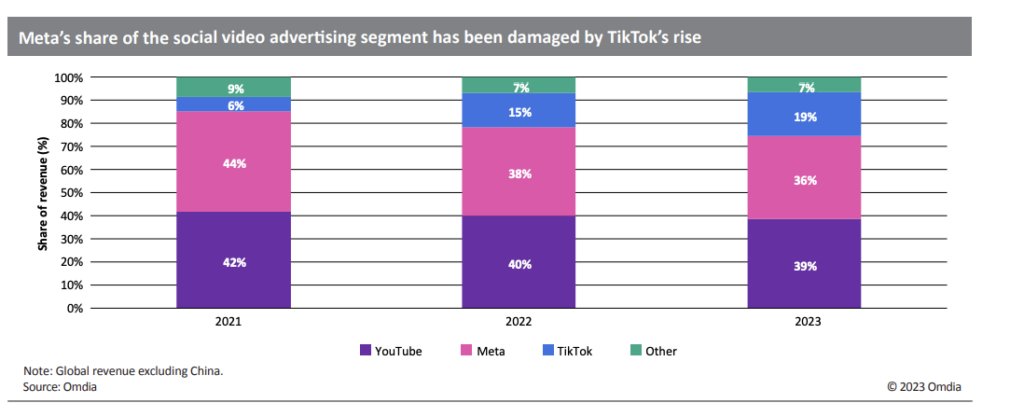Advertising: Meta takes on X (formerly Twitter) with Threads

Following years of boisterous growth, Meta’s annual net advertising revenue declined by just over 1% in 2022. While part of this decline was due to an increasingly harsh macroeconomic environment and unfavorable exchange rate fluctuations, there were other major contributing factors. Meta has been badly affected by Apple’s privacy-focused changes to iOS, including the deprecation of the identifier for advertisers (IDFA), which has limited its ability to serve performance oriented advertisers seeking attribution outside Meta’s walled garden. More stringent privacy policies from platform holders and regulators will continue to threaten Meta’s advertising business and pressure the company to open its walled garden ecosystem.
The dynamic rise of TikTok, which has rapidly eaten into Meta’s share of the global social video advertising segment, is another key factor contributing to the slowdown in Meta’s advertising business. Indeed, while TikTok advertising revenue grew by almost 160% outside China during 2022, Meta video advertising revenue fell by around 6%, according to Omdia data. Meta has sought to compete with TikTok through its Reels short-form video format. Although Meta has enjoyed significant levels of engagement with Reels, this has come at the expense of its other social media formats and platforms. This is crucial, as Meta has thus far been unable to monetize time spent with Reels at the same rate as its legacy feed-based formats and platforms because of the need to encourage early uptake and develop new ad formats and campaign types. Meanwhile, TikTok has been able to ramp up ad revenue by capturing the attention of young mobile users and boosting its offering to brands looking to target this audience. In contrast to TikTok, X is very much on a downward trend when it comes to user engagement and monetization. Concerns over brand safety on the platform have coincided with an exodus of users to severely reduce the share of social ad budgets going to X.
In this context, it is unsurprising to see Meta directly target X’s market position with Threads, given its growing need to increase the number of touchpoints it has with its users (i.e., opportunities to serve ads), its relatively better track record at monetizing more traditional social feeds, and pressure to diversify away from an increasingly competitive social video segment.
Although ads are not a launch feature of Threads, Meta is already laying the groundwork for it to pick up where X has left off in terms of brand activity on the platform. Should it achieve enough scale—and early signs are positive—it is only a matter of time before Meta flips the switch to enable advertising in Threads, opening a potentially substantial new ad revenue stream.
Matthew Bailey is a principal analyst, media and entertainment, at Omdia.
